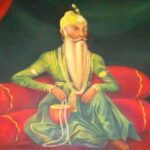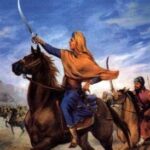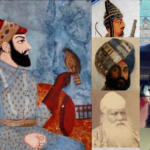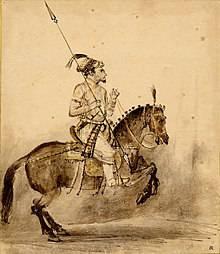The Sikh Empire, also known as the Sikh Kingdom of Punjab, was a significant chapter in the history of the Indian subcontinent. Emerging in the early 19th century, the Sikh Empire grew to become one of the most powerful and influential states in the region. Led by dynamic leaders and bolstered by the principles of Sikhism, the empire witnessed a period of remarkable growth and prosperity. The Lion of the Punjab or Sher-e-Punjab, Maharaja Ranjit Singh, was born in Gujranwala, now in Pakistan, on November 13, 1780. The Sikh state of Punjab was founded by a great warrior and monarch.
He was the first Indian in a millennium to reverse the flow of invasion away from the Pashtuns’ (Afghans’) traditional strongholds. His possessions extended from Kashmir, the northernmost region of the Indian subcontinent, south to the Thar (Great Indian) Desert, and from the Khyber Pass in the northwest to the Sutlej River in the east. Afghanistan has only been vanquished by the Punjab state.
Origins of the Sikh Empire
The roots of the Sikh Empire can be traced back to the late 18th century when the Sikh faith, founded by Guru Nanak in the 15th century, had gained a significant following in the Punjab region. The Sikh community, known for its martial traditions and commitment to justice and equality, faced oppression under the rule of the Mughal Empire.
In the mid-18th century, Banda Singh Bahadur, a prominent Sikh leader, led a rebellion against the Mughal rulers, establishing a brief period of Sikh rule in parts of Punjab. However, after his capture and execution by the Mughals, the Sikh community faced further persecution.
The Rise of Maharaja Ranjit Singh
In the early 19th century, a remarkable figure emerged within the Sikh community, Maharaja Ranjit Singh. Born in 1780 in Gujranwala (now in Pakistan), Ranjit Singh rose to power as the leader of the Sukerchakia Misl, one of the many Sikh misls (confederacies).
Through a series of strategic alliances, military campaigns, and deft diplomacy, Ranjit Singh gradually united the various Sikh misls under his rule. By 1801, he had established himself as the undisputed leader of the Sikh Empire, with its capital at Lahore.
Consolidation of Power and Reforms
Under Maharaja Ranjit Singh’s visionary leadership, the Sikh Empire experienced a period of consolidation and reforms. Ranjit Singh introduced administrative reforms, creating a well-organized and efficient bureaucracy. He encouraged religious tolerance, allowing people of different faiths to practice their beliefs freely.
The Maharaja’s Court also attracted notable intellectuals, poets, and artists, making Lahore a center of cultural and intellectual exchange. The empire thrived economically through trade, agriculture, and the development of industries, such as textiles and handicrafts.
Lahore and Amritsar victories
According to reports, Ranjit Singh is blind in one eye. He was the only child of Maha Singh, and at the age of 12, after his father’s passing, he took over as leader of the Shukerchakias, a Sikh tribe. The inheritance included the town of Gujranwala and the nearby villages, which are now in Pakistan.
He seized control of Lahore in 1799, which is today the capital of Pakistan’s Punjab province. Ranjit Singh was recognized as the city’s governor by the Afghan ruler Zamn Shah, but in 1801 Ranjit Singh proclaimed himself Maharaja of Punjab. To rule the state in the name of the Sikh commonwealth, he had coins minted in their honor.
Military Prowess and Territorial Expansion
The Sikh Empire was renowned for its formidable military prowess. The Khalsa Army, consisting of highly disciplined and skilled Sikh soldiers, played a vital role in expanding the empire’s territory. Under Ranjit Singh’s leadership, the empire’s borders expanded to include Kashmir, Peshawar, and parts of present-day Pakistan and Afghanistan.
Despite facing invasions from the British East India Company, Ranjit Singh’s military acumen allowed him to secure the empire’s independence and maintain a delicate balance of power with the British.
Legacy and Decline
Maharaja Ranjit Singh’s death in 1839 marked the beginning of the Sikh Empire’s decline. Internal power struggles and weak leadership led to instability and fragmentation. The British took advantage of the situation and annexed Punjab in 1849, after the decisive Battle of Gujrat.
Though the Sikh Empire had a relatively short existence, it left a lasting impact on the history and culture of the Indian subcontinent. The legacy of Sikh rule in Punjab remains evident in various architectural marvels, such as the Golden Temple in Amritsar and historical sites in Lahore.
The rise of the Sikh Empire under Maharaja Ranjit Singh was a testament to the indomitable spirit, military prowess, and visionary leadership of the Sikh community. The empire’s period of prosperity and cultural richness showcased the enduring principles of Sikhism, promoting equality, justice, and religious tolerance.
Though the Sikh Empire eventually succumbed to external pressures and internal challenges, its legacy remains an integral part of Punjab’s history and identity. The glorious period of Punjab’s Sikh rule continues to be celebrated and remembered, serving as a source of inspiration for generations to come.








